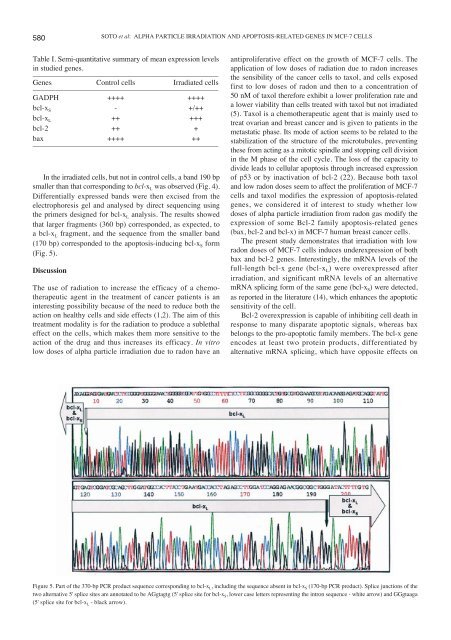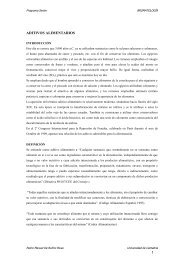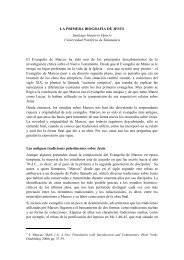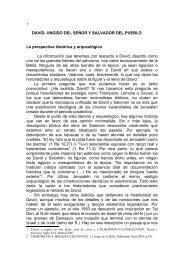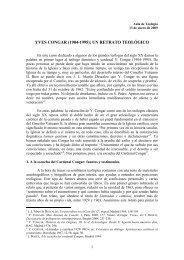580SOTO et al: ALPHA PARTICLE IRRADIATION AND APOPTOSIS-RELATED GENES IN MCF-7 CELLSTable I. Semi-quantitative summary of mean expression levelsin studied genes.–––––––––––––––––––––––––––––––––––––––––––––––––Genes Control cells Irradiated cells–––––––––––––––––––––––––––––––––––––––––––––––––GADPH ++++ ++++bcl-x S - +/++bcl-x L ++ +++bcl-2 ++ +bax ++++ ++–––––––––––––––––––––––––––––––––––––––––––––––––In the irradiated cells, but not in control cells, a band 190 bpsmaller than that corresponding to bcl-x L was observed (Fig. 4).Differentially expressed bands were then excised from theelectrophoresis gel and analysed by direct sequencing usingthe primers <strong>de</strong>signed for bcl-x L analysis. The results showedthat larger fragments (360 bp) correspon<strong>de</strong>d, as expected, toa bcl-x L fragment, and the sequence from the smaller band(170 bp) correspon<strong>de</strong>d to the apoptosis-inducing bcl-x S form(Fig. 5).DiscussionThe use of radiation to increase the efficacy of a chemotherapeuticagent in the treatment of cancer patients is aninteresting possibility because of the need to reduce both theaction on healthy cells and si<strong>de</strong> effects (1,2). The aim of thistreatment modality is for the radiation to produce a sublethaleffect on the cells, which makes them more sensitive to theaction of the drug and thus increases its efficacy. In vitrolow doses of alpha particle irradiation due to radon have anantiproliferative effect on the growth of MCF-7 cells. Theapplication of low doses of radiation due to radon increasesthe sensibility of the cancer cells to taxol, and cells exposedfirst to low doses of radon and then to a concentration of50 nM of taxol therefore exhibit a lower proliferation rate anda lower viability than cells treated with taxol but not irradiated(5). Taxol is a chemotherapeutic agent that is mainly used totreat ovarian and breast cancer and is given to patients in themetastatic phase. Its mo<strong>de</strong> of action seems to be related to thestabilization of the structure of the microtubules, preventingthese from acting as a mitotic spindle and stopping cell divisionin the M phase of the cell cycle. The loss of the capacity todivi<strong>de</strong> leads to cellular apoptosis through increased expressionof p53 or by inactivation of bcl-2 (22). Because both taxoland low radon doses seem to affect the proliferation of MCF-7cells and taxol modifies the expression of apoptosis-relatedgenes, we consi<strong>de</strong>red it of interest to study whether lowdoses of alpha particle irradiation from radon gas modify theexpression of some Bcl-2 family apoptosis-related genes(bax, bcl-2 and bcl-x) in MCF-7 human breast cancer cells.The present study <strong>de</strong>monstrates that irradiation with lowradon doses of MCF-7 cells induces un<strong>de</strong>rexpression of bothbax and bcl-2 genes. Interestingly, the mRNA levels of thefull-length bcl-x gene (bcl-x L ) were overexpressed afterirradiation, and significant mRNA levels of an alternativemRNA splicing form of the same gene (bcl-x S ) were <strong>de</strong>tected,as reported in the literature (14), which enhances the apoptoticsensitivity of the cell.Bcl-2 overexpression is capable of inhibiting cell <strong>de</strong>ath inresponse to many disparate apoptotic signals, whereas baxbelongs to the pro-apoptotic family members. The bcl-x geneenco<strong>de</strong>s at least two protein products, differentiated byalternative mRNA splicing, which have opposite effects onFigure 5. Part of the 370-bp PCR product sequence corresponding to bcl-x L , including the sequence absent in bcl-x S (170-bp PCR product). Splice junctions of thetwo alternative 5' splice sites are annotated to be AGgtagtg (5' splice site for bcl-x S , lower case letters representing the intron sequence - white arrow) and GGgtaaga(5' splice site for bcl-x L - black arrow).
ONCOLOGY REPORTS 15: 577-581, 2006 581apoptotic induction. Full-length bcl-x L is homologous to bcl-2 and has a similar ability to inhibit cell <strong>de</strong>ath by multiplepathways. The truncated bcl-x S protein is able to inhibit theaction of either bcl-2 or bcl-x L , and enhances the apoptoticsensitivity of the cell.Despite the different source of alpha radiation, the effectsobserved in our study can be compared with those found with239Pu sources. A representative example of the studies performedwith this type of irradiation is the study by Kadhimet al (23), who ma<strong>de</strong> interesting observations concerningthe number of cells that suffer direct interactions with alphaparticles, which was similar to that found by Mays et al(24). These studies suggest that, for low radiation doses, thepercentage of cells affected by alpha particles is small andthe effects observed are mainly indirect, due to the creationof chemical species in the culture medium and to the furtheraction of these on DNA or, more frequently, on RNA.Radiation-induced gene expression in MCF-7 cells has beenrecently <strong>de</strong>scribed and, simultaneously, both the inhibition ofcell proliferation and that of other cellular functions (e.g. cellrepair) have been found (25).The changes in the splicing sites that were <strong>de</strong>tected in thebcl-x gene following irradiation would seem to confirm theindirect effect. Bcl-x S transcript formation results from thesecuts produced by radiation in two specific loci of the mRNAchain. By aligning the human bcl-x L and bcl-x S cDNA with thebcl-x genomic from GenBank (8), the splice junctions of thealternative 5' splice sites are annotated to be AGgtagtg (5'splice site for bcl-x S , lower case letters representing the intronsequence) and GGgtaaga (5' splice site for bcl-x L ) (26) (Fig. 5).Consi<strong>de</strong>ring the stochastic character of energy <strong>de</strong>positions dueto radiation, the induced lesions appear to be a consequenceof a chemical interaction at all points of the mRNA molecule,with breakage occurring at the weakest. In the study byKadhim et al (23), the effect of alpha irradiation is manifestedas a chromosomal instability that is transmitted to the progenyof the irradiated hematopoietic cells. This chromosomalinstability and the resulting increased mutagenicity wouldseem to be paralleled by the increased expression of bcl-x Lfound in our study. Since irradiation with alpha particlesincreases expression of bcl-x L , it results in <strong>de</strong>creased apoptosisand elimination of cells with a high <strong>de</strong>gree of mutation, therebyincreasing the possibility of mutagenesis.However, the increased sensitivity to apoptosis resultingfrom bcl-x S overexpression is important because it mightimprove the efficacy of chemotherapeutic agents in the treatmentof cancer. The study by Sumantran et al (11) showedthat the chemotherapeutic agent, taxol, was more effective ifMCF-7 tumor cells had been previously treated to induce bcl-x Sexpression by means of an a<strong>de</strong>novirus vector. Our finding thatlow radiation doses of alpha particles induce bcl-x S expressionopens up the possibility for application of this naturallyoccurring agent for the same purpose.References1. Rosenthal DI and Carbone DP: Taxol plus radiation for headand neck cancer. J Infus Chem 5: 46-54, 1995.2. Vokes EE and Weichselbaum RR: Concomitant chemoradiotherapy:rationale and clinical experience in patients with solidtumors. J Clin Oncol 8: 911-934, 1990.3. Kharazi AI, James SJ, Taylor JMG, Lubinski JM, Nakamura LTand Makinodan T: Combined chronic low dose radiation-caloricrestriction: a mo<strong>de</strong>l for regression of spontaneous mammarytumor. Int J Radiat Oncol Biol Phys 28: 641-647, 1994.4. <strong>Soto</strong> J, Quindós LS, Cos S and Sánchez-Barceló EJ: Influenceof low doses of radiation due to 222 Rn on proliferation of fibroblastsand MCF-7 human breast cancer cells in vitro. Sci TotalEnviron 181: 181-185, 1996.5. <strong>Soto</strong> J, Sáinz C, González-Lamuño D, Falkenbach A and Cos S:Low radon doses sensitize MCF-7 human breast cancer cells totaxol. Oncol Rep 7: 941-944, 2000.6. Korsmeyer S: Bcl-2 initiates a new category of oncogenes:regulators of cell <strong>de</strong>ath. Blood 80: 879-887, 1992.7. Minn A, Rudin C, Boise L and Thompson C: Expression ofbcl-x L can confer a multidrug resistance phenotype. Blood 86:1903-1910, 1995.8. Boise L, Gonzalez-Garcia M, Postema C, Ding L, Lindsten T,Turke L, Mao X, Nuñez G and Thompson C: Bcl-x, a bcl-2related gene that functions as a dominant regulator of apoptosiscell <strong>de</strong>ath. Cell 74: 597-608, 1993.9. Oltvai Z, Milliman C and Korsmeyer S: Bcl-2 heterodimerizesin vivo with a conserved homolog, bax, that acceleratesprogrammed cell <strong>de</strong>ath. Cell 74: 609-619, 1993.10. Zhan Q, Alamo I, Yu K, Boise L, Cherney B, Tosato G,O'Connor P and Fornace A: The apoptosis associated gammarayresponse of bcl-x L <strong>de</strong>pends on normal p53 function. Oncogene13: 2287-2293, 1996.11. Sumantran VN, Eslovega MW, Nuñez G, Clarke MF andWicha MS: Overexpression of bcl-x S sensitizes cells to chemotherapy-inducedapoptosis. Cancer Res 55: 2507-2510, 1995.12. Wang B, Takeda H, Gao W, Zhou K, Odaka T, Ohyama H,Yamada T and Hayata I: Induction of apoptosis by beta radiationfrom tritium compounds in mouse embryonic brain cells. HealthPhys 77: 16-23, 1999.13. Ducau J, Breglians J and Saint-André C: Gamma irradiationstimulates homology directed DNA double strand break repairin Drosophila embryo. Mutat Res 460: 69-80, 2000.14. Lorimore S, Kadhim M, Pocock D, Papworth D, Steves D,Goodhead D and Wright E: Chromosomal instability in the<strong>de</strong>scendants of unirradiated surviving cells after alpha particleirradiation. Proc Natl Acad Sci USA 10: 5710-5733, 1998.15. Pohl-Ruling J, Lettner H, Hoffmann W, Eckl P, Haas O andObe G: Chromosomal aberrations of blood lymphocytes inducedin vitro by radon 222 daughter alpha irradiation. Mutat Res 449:7-19, 2000.16. Georgakilas A, Haveles K, Sophianopoulou V, Sakellion L,Zarris G and Si<strong>de</strong>ris E: Alpha particle induced changes in thestability and size of DNA. Radiat Res 153: 258-262, 2000.17. United Nations Scientific Committee on the effects of AtomicRadiation: Sources and Effects of Ionizing Radiation. UNSCEAR2000 Report to the General Assembly with Annexes, New York.Volume II: Effects. United Nations Publication, Sales No.E.00.IX.4, New York, 2000.18. Goodhead D: Spatial and temporal distribution of energy.Health Phys 55: 231-240, 1988.19. Baverstock K and Thorne M: An illustrative comparison of theevent-size distribution for gamma-rays and alpha particles in thewhole mammalian cell nucleus. Int J Radiat Biol 74: 799-804,1998.20. <strong>Soto</strong> J, Sáinz C, Cos S and González-Lamuño D: A simplemethod of alpha irradiation for experiments in radiobiology.Nucl Instr Meth Phys Res B 197: 310-316, 2002.21. Chomzcynsky P and Sacchi N: Single step method of RNAisolation by and guanidinium thiocyanate-phenol-chloroformextraction. Anal Biochem 162: 156-159, 1987.22. Holmes FA, Walkers RS, Theriault RL, Forman AD, Newton LK,Raber MN, Buzdar AV, Frue D and Hortobagyi GN: Phase IItrial of taxol, an active drug in the treatment of metastasic breastcancer. J Natl Cancer Inst 83: 1797-1805, 1991.23. Kadhim M, MacDonald D, Goodhead D, Lorimore S, Mars<strong>de</strong>n Sand Wright E: Transmission of chromosomal instability afterplutonium alpha particle irradiation. Nature 355: 738-740, 1992.24. Mays C, Lloyd R and Wrenn T: Cancer inci<strong>de</strong>nce and lifespanvs alpha particle dose in beagles. Health Phys 52: 617-624, 1987.25. Stassen T, Port M, Nuyken I and Abend M: Radiation-inducedgene expression in MCF-7 cells. Int J Radiat Biol 79: 319-331,2003.26. Burge CB, Padgett RA and Sharp PA: Evolutionary fates andorigins of U12-type introns. Mol Cell 2: 773-785, 1998.


